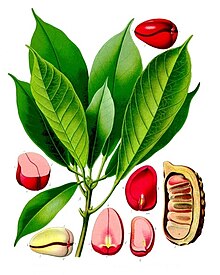Read more
The term kola nut usually refers to the seeds of certain species of plant of the genus Cola, placed formerly in the cocoa family Sterculiaceae and now usually subsumed in the mallow family Malvaceae (as subfamily Sterculioideae). These cola species are trees native to the tropical rainforests of Africa. Their caffeine-containing seeds are used as flavoring ingredients in beverages applied to various carbonated soft drinks, from which the name cola originates.[1]
General description[edit]
The kola nut is a caffeine-containing nut of evergreen trees of the genus Cola, primarily of the species Cola acuminata and Cola nitida.[2] Cola acuminata, an evergreen tree about 20 meters in height, has long, ovoid leaves pointed at both the ends with a leathery texture. The trees have cream flowers with purplish-brown striations, and star-shaped fruit consisting of usually 5 follicles. Inside each follicle, about a dozen prismatic seeds develop in a white seed-shell. The nut’s aroma is sweet and rose-like. The first taste is bitter, but it sweetens upon chewing. The nut can be boiled to extract the caffeine.[citation needed]
Kola nuts contain about 2–4% caffeine and theobromine,[2] as well as tannins, alkaloids, saponins, and flavonoids.[3]
Uses[edit]
The kola nut has a bitter flavor and contains caffeine. It is chewed in many West African countries, in both private and social settings.[4] It is often used ceremonially, presented to chiefs or guests.[5] In folk medicine, kola nuts are considered useful for aiding digestion when ground and mixed with honey, and are used as a remedy for coughs.[6] Kola nuts are perhaps best known to Western culture as a flavoring ingredient and one of the sources of caffeine in cola and other similarly flavored beverages, although kola nut extract is no longer used in major commercial cola drinks such as Coca-Cola.[1][7]
History[edit]
Human use of the kola nut, like the coffee berry and tea leaf, appears to have ancient origins. It is chewed in many West African cultures, in both private and social settings, as a source of mental stimulation.[1]
The spread of the kola nut across North Africa seems to be connected to the spread of Islam across North Africa during the 17th century, as trading across the Mediterranean became more concrete. The kola nut was particularly useful on slave ships to improve the taste of water, as enslaved Africans were often given poor quality water to drink.[8]
Kola nuts are an important part of the traditional spiritual practice , culture, and religion in West Africa, particularly Niger, Nigeria, Sierra Leone and Liberia.[1][9] The 1970s hit "Goro City", by Manu Dibango, highlights the significance of kola nuts (called "goro" in the Hausa language)[10] to the capital of Niger, Niamey. Kola nuts are used as a religious object and sacred offering during prayers, ancestor veneration, and significant life events, such as naming ceremonies, weddings, and funerals. For this use, only kola nuts divided into four lobes are suitable. They are cast upon a special wooden board and the resulting patterns are read by a trained diviner.[11] Among a few Yoruba people, it has found inroads among the Muslim population as well, in weddings and other ceremonies.[12]
They were used as a form of currency in such West African groups as the Malinke and Bambara of Mali and Senegal. They are still used as such today in certain situations such as in negotiation over bride prices or as a form of a respect or host gift to the elders of a village should one move to a village or enter a business arrangement with the village.







.jpg)

.jpg)




0 Reviews